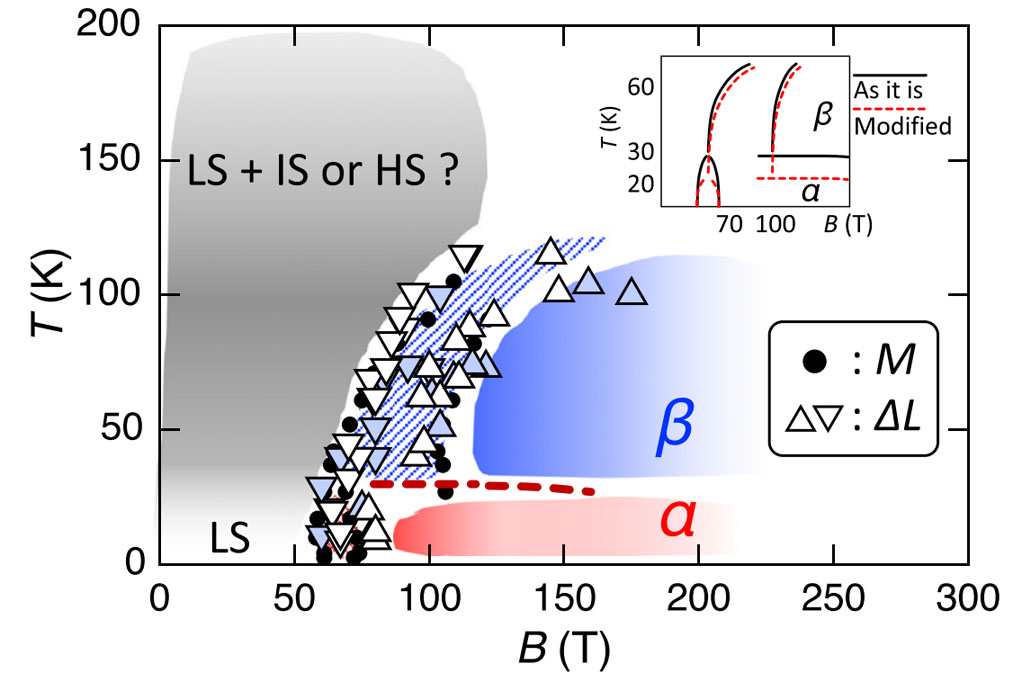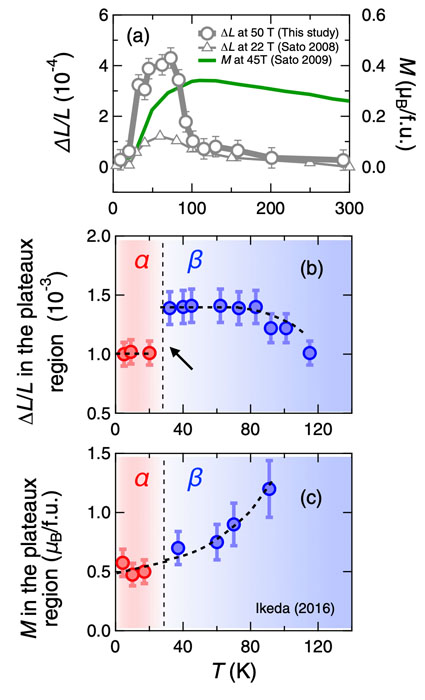Two Spin-State Crystallizations in LaCoO3 up to 200 T
Y. H. Matsuda Group
The puzzling properties of LaCoO3 have been drawing the attention of researchers for more than 60 years, regarding the uncovered origin of the magnetic and insulating state at intermediate temperature range of 100 - 500 K. LaCoO3 is characterized by the spin-state degrees of freedom that governs the temperature evolution of the electronic and magnetic properties. The origin of the magnetic and insulating state between 100 - 500 K is quite controversial, although it has been widely accepted that the ground state is the low spin (LS) non-magnetic insulator. As the origin of the magnetic states, some argue that the intermediate spin state (IS) is involved, while others claim that the mixture of the LS and high spin (HS) states is important. Many experimental results support each claim, being unable to put an end to the long-standing discussion. We believe that this controversy is rooted in the itineracy-localization duality of correlated electrons in LaCoO3.
We tackled this long-standing problem by using pulsed ultrahigh magnetic field beyond 100 T because beyond 100 T are supposed to be useful in controlling the excited spin-states. In the previous study of ours, we discovered two kinds of spin-state orderings, α and β phases that are extended beyond 100 T on the B-T phase diagram [1], by means of magnetization measurements using the induction method. However, the magnetization study shows only little information on the difference between the uncovered α and β phases, especially regarding the spin-state configurations.
We came up with an idea that magnetostriction measurement will supplement the magnetization study because the spin-state degree of freedom is coupled with the lattice volume even more directly than magnetization is. For this purpose, we have developed an ultrahigh speed magnetostriction measurement instrument utilizing the fiber Bragg grating (FBG) and optical filter method [2], for the measurement above 100 T. By means of the FBG based method, we have successfully revealed the magneto-lattice properties of LaCoO3 up to 200 T [3]. The result shows very clearly that α and β phases are quite different in volume and that both have constant volume above 100 T, indicating both phases are super-lattice formations (crystallizations) of the spin-states. We have claimed several possible crystallizations in the paper [3]. The result clearly shows that the spin-state interactions lead to kinds of long-range ordering in LaCoO3. At this moment, we still do not know why the ordering is present only in high magnetic fields. We further push the study to even higher magnetic field of 600 T using electromagnetic flux compression method and FBG based magnetostriction measurements, which have clarified even exotic phase diagram up to 600 T [4].
References
- [1] A. Ikeda, T. Nomura, Y. H. Matsuda, A. Matsuo, K. Kindo, and K. Sato, Phys. Rev. B 93, 220401(R) (2016).
- [2] A. Ikeda, T. Nomura, Y. H. Matsuda, S. Tani, Y. Kobayashi, H. Watanabe, K. Sato, Rev. Sci. Instrum. 88, 083906 (2017).
- [3] A. Ikeda, Y. H. Matsuda, and K. Sato, Phys. Rev. Lett. 125, 177202 (2020).
- [4] A. Ikeda, Y. H. Matsuda, K. Sato, Y. Ishii, H. Sawabe, D. Nakamura, S. Takeyama, and J. Nasu, arXiv:2201.02704.


